Table of Contents
Engine Coolant Temperature Not Displayed: Mercedes-Benz E Class W213 Case Study
When the engine coolant temperature is not displayed on the dashboard, it may seem like a small inconvenience. However, in vehicles like the Mercedes-Benz E Class W213 Equipped with M274 Engine, this issue can be the early warning sign of a more serious problem within the cooling system.
In this case study, we’ll look at how a workshop diagnosed and repaired an issue where the engine coolant temperature was not displayed on the instrument cluster, and the cooling fan ran at full speed, even during a cold start.
By the end of this guide, you’ll understand the importance of the engine coolant temperature sensor (ECT sensor), the role it plays in protecting the engine, and how to recognize and fix faults before they lead to overheating or poor performance.
Vehicle Profile
- Model: Mercedes-Benz E Class W213
- Engine: M274
- Complaint: Engine coolant temperature not displayed on cluster + cooling fan running at high speed.
Step 1: Customer Complaint
The customer noticed two key problems:
- 1. No coolant temperature reading on the instrument cluster.
- 2. Cooling fan running at maximum speed, even when the engine was started cold.
This second symptom is a built-in safety response from the ECU (Engine Control Unit). When the ECU cannot detect coolant temperature, it defaults to maximum cooling to prevent potential overheating.

Step 2: Initial Assessment
The technician first verified the issue. As suspected, the coolant temperature gauge remained inactive, and the fan operated at high speed from start-up.
At first glance, one possible cause could have been high refrigerant pressure in the air conditioning system, which can sometimes trigger fan speed increase. But after further inspection, the missing coolant temperature display was prioritized as the likely root problem.
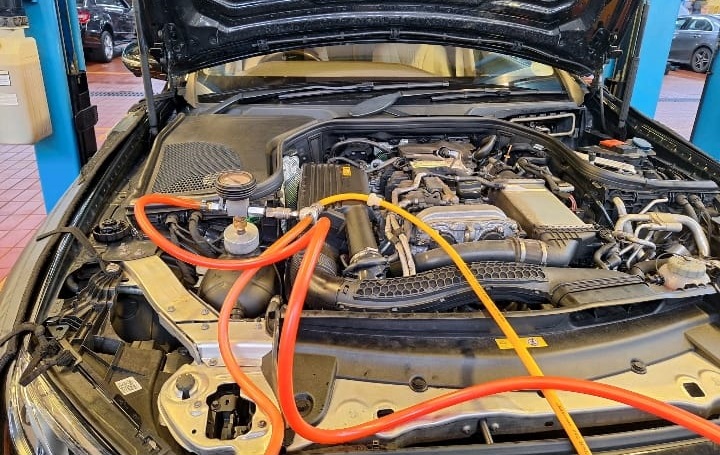
Step 3: Diagnostic Procedure
1. Fault Code Scan
The car was connected to a diagnostic tool (Mercedes-Benz XENTRY).
- – Fault Code: Coolant Temperature Sensor Malfunction
This aligned perfectly with the symptoms: missing display and default fan operation.
2. Coolant Level Check
- – Coolant was checked to ensure it was at the correct level.
- – While the level was normal, a low coolant condition can sometimes interfere with proper sensor operation.
3. Electrical Circuit Inspection
- – Wires and connectors leading to the coolant temperature sensor were checked.
- – No open circuits, loose connections, or corrosion were found.

4. Sensor Resistance Test
Using a multimeter, the technician measured the resistance of the coolant temperature sensor.
- – Reading: 6 MΩ (megaohms)
- – Expected: Much lower at operating temperature.
This abnormal reading suggested that the sensor was faulty.
Engine Coolant Temperature Sensor Resistance Values (Approx.)
| Coolant Temperature (°C) | Resistance (Ω) |
|---|---|
| 0 °C (cold start) | ~ 5,000 – 6,000 Ω |
| 20 °C (room temperature) | ~ 2,500 – 3,000 Ω |
| 40 °C | ~ 1,200 – 1,500 Ω |
| 60 °C | ~ 500 – 700 Ω |
| 80 °C (normal operating temp) | ~ 250 – 350 Ω |
| 100 °C (high temp) | ~ 150 – 200 Ω |
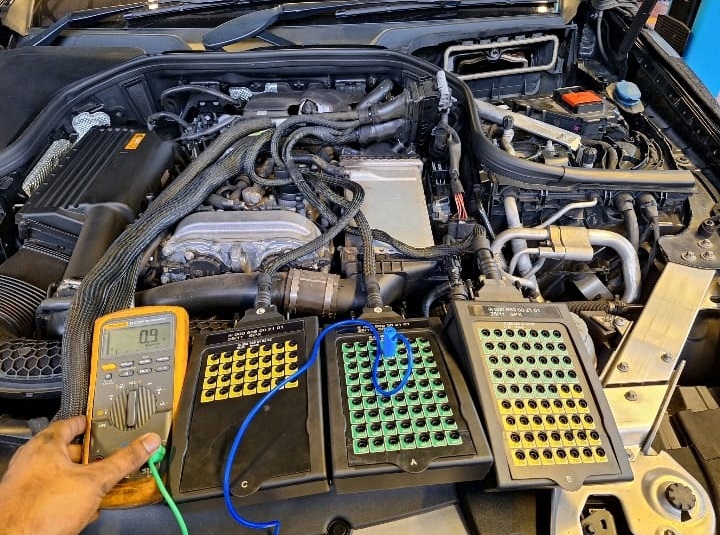
5. Temperature Comparison Test
- – The actual coolant temperature was measured with an external thermometer.
- – This was compared with the ECU’s sensor reading.
- – The mismatch confirmed that the sensor was not providing correct data.
Step 4: Corrective Action
The diagnosis pointed to a faulty coolant temperature sensor.
Repairs Performed:
- – Replaced coolant temperature sensor with a genuine Mercedes part.
- – Refilled coolant where necessary.
- – Cleared fault codes and retested.
Post-Repair Verification:
- – The instrument cluster displayed the correct coolant temperature.
- – The cooling fan operated normally, no longer stuck on high speed.
- – A road test confirmed that the engine warmed up and cooled down properly.
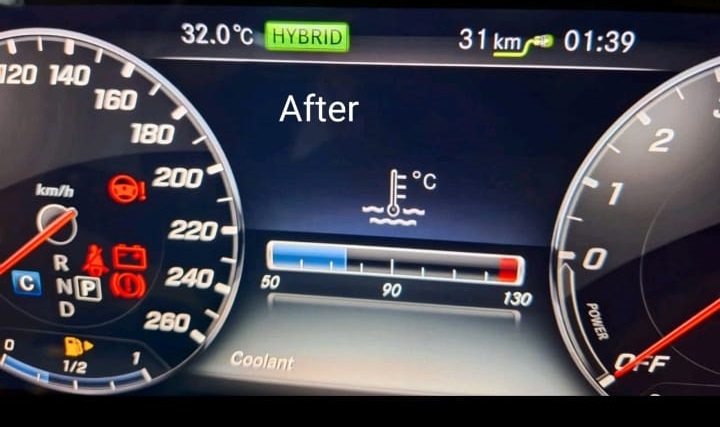
Common Causes and Solutions for Engine Coolant Temperature Not Displayed
| Symptom | Possible Cause | Diagnostic Check | Solution |
|---|---|---|---|
| Coolant temperature not displayed on cluster | Faulty coolant temperature sensor | Scan for fault codes (e.g., P0115, P0116, P0117) | Replace coolant temperature sensor |
| Cooling fan running at full speed during cold start | ECU in fail-safe mode due to missing/incorrect temperature data | Check sensor wiring, resistance test | Repair wiring or replace sensor |
| Fluctuating or inaccurate temperature readings | Loose/corroded electrical connector | Visual inspection of harness & connector | Clean or replace connector |
| Check engine light on | Sensor circuit open/short | Multimeter test of resistance & continuity | Repair circuit, replace sensor if needed |
| Engine overheating | Sensor not activating fan correctly | Compare actual coolant temperature with scan tool values | Replace faulty sensor and top up coolant |
Understanding the Engine Coolant Temperature Sensor
The engine coolant temperature sensor (ECT sensor) is a small but critical part of modern vehicles. It directly influences cooling, fuel injection, emissions, and overall engine performance.
Functions of the ECT Sensor
- – Temperature Monitoring: Feeds real-time coolant temperature data to the ECU.
- – Engine Warm-Up Control: Ensures richer fuel mixture on cold starts until operating temperature is reached.
- – Cooling Fan Operation: Signals ECU to activate or deactivate the fan.
- – Fuel Injection Timing: Adjusts mixture depending on engine temperature.
- – Emission Control: Maintains optimal catalytic converter performance.
How the Sensor Works
The ECT sensor is usually a thermistor.
- – At low temperature → High resistance.
- – At high temperature → Low resistance.
The ECU interprets this resistance change as temperature data. A faulty sensor disrupts this process, forcing the ECU into a fail-safe mode (fan on high speed, gauge disabled).
Symptoms of a Faulty Coolant Temperature Sensor
- 1. Coolant Temperature Not Displayed on the dashboard.
- 2. Cooling fan stuck at high speed during cold starts.
- 3. Poor fuel economy due to incorrect air-fuel mixture.
- 4. Hard starting in cold weather.
- 5. Check Engine Light illuminated with related fault codes.
- 6. Engine overheating if the fan fails to activate when truly needed.
Engine Coolant Temperature Sensor Location in Mercedes W213
- – Typically located near the thermostat housing.
- – Monitors coolant as it exits the engine and flows to the radiator.
- – This placement ensures the ECU receives the most accurate reading of actual engine coolant temperature.
Testing & Replacing the ECT Sensor
Testing:
- – Disconnect the sensor and measure resistance with a multimeter.
- – Compare results with manufacturer specifications at different temperatures.
Replacement Procedure:
- 1. Locate the sensor (usually near the thermostat housing).
- 2. Disconnect the electrical connector.
- 3. Unscrew and remove the old sensor.
- 4. Install the new sensor and reconnect wiring.
- 5. Top up coolant if necessary.
- 6. Start engine, bleed air from cooling system, and verify correct operation.
Preventive Tips
- – Check coolant levels regularly. Low coolant can trigger false readings.
- – Inspect wiring harnesses. Damaged connectors are common culprits.
- – Flush coolant system every 2–3 years to prevent buildup that may affect sensor operation.
- – Use only genuine sensors. Aftermarket sensors often provide inaccurate resistance curves.
- – Address early signs such as high fan speed or missing gauge readings before overheating occurs.
Conclusion
This Mercedes-Benz E Class W213 case study highlights how a seemingly simple problem engine coolant temperature not displayed can quickly escalate if ignored.
By following a structured diagnostic process from verifying symptoms to testing the sensor the workshop correctly identified and replaced the faulty coolant temperature sensor.
The result?
- – Accurate temperature display restored.
- – Cooling fan operation normalized.
- – Engine performance protected.
Understanding the role of the ECT sensor and recognizing its failure symptoms can save both time and money, preventing overheating and costly engine damage.
More Mercedes Cooling System Resources
Want to explore more causes, symptoms, and repair tips for coolant leaks, overheating, and contamination?
Learn more about Mercedes cooling system faults in our full Cooling System Guide.
Frequently Asked Questions (FAQs)
1. Why is my engine coolant temperature not displayed on the dashboard?
This usually happens due to a faulty coolant temperature sensor, damaged wiring, or an electrical communication fault with the ECU. In fail-safe mode, the cooling fan may also run at full speed to prevent overheating.
2. Can I drive my Mercedes if the coolant temperature is not displayed?
It’s not recommended. Without proper coolant temperature monitoring, the engine could overheat without warning. Continuous fan operation also indicates that the ECU is in protection mode, which should be addressed immediately.
3. How do I know if my coolant temperature sensor is bad?
Common symptoms include no temperature reading, cooling fan stuck at high speed, poor fuel economy, hard starting in cold weather, and a check engine light with related fault codes.
4. Where is the coolant temperature sensor located in a Mercedes E Class W213?
The sensor is typically located near the thermostat housing or engine block, where it can accurately monitor coolant as it exits the engine.
5. How much does it cost to replace a coolant temperature sensor in a Mercedes?
On average, replacement costs range from $120–$250, depending on labor rates and whether a genuine Mercedes part is used.
Author
Written by: Mercedes Expert
Automotive Technical Trainer & Mercedes-Benz Diagnostic Specialist
With years of hands-on experience repairing and diagnosing Mercedes-Benz vehicles, specializes in case-study-based troubleshooting guides that blend workshop accuracy with educational clarity.
Last Updated: August 2025
— Salim, Mercedes Expert
Independent specialist in Mercedes-Benz diagnostics, CAN Bus analysis, troubleshooting case studies, and EV systems.

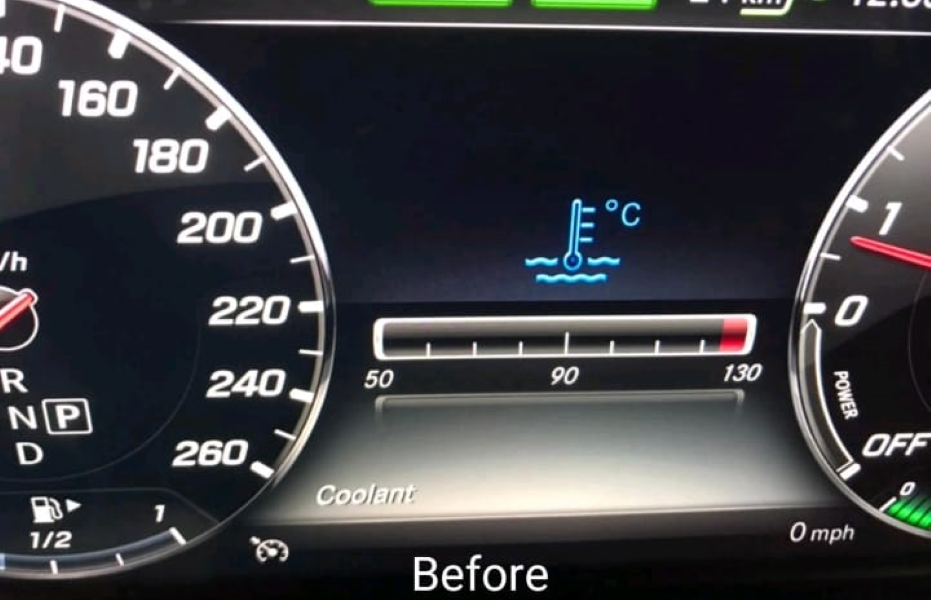

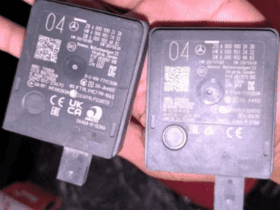


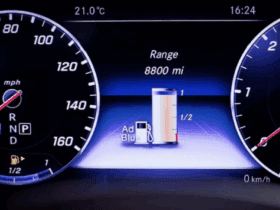
Leave a Reply